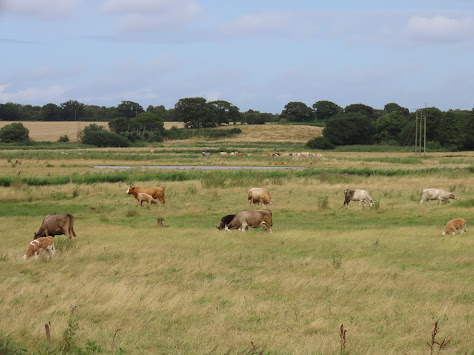In the birdwatching world not too many places that can be like Minsmere, the kind of reserve that packs the birds in no matter what season. Even the best places can be quiet in the off season. So it was on a very quiet day that I went over to visit Hen Reedbeds. It was your typical August day, low on spectacle and low on energy. There wasn't really anything to see on the reserve, but I decided to include a post for completion's sake.
Hen Reedbeds is a Suffolk Wildlife Trust reserve, where they have flooded a river valley and let it become overgrown with reeds. It sits beside the Blyth Estuary, and with all estuaries timing is important as birding is always dependent on the tides and how much mud is exposed. As is the case when you don't plan for tides they are always either too high or too low, always at a height that's not best for birds. So today the tide was high and as a result there was little to see from the estuary. Walking along Hen Reedbeds there were a lot of BLACKWITS, with smaller numbers of CURLEW, OYSTERCATCHERS and DUNLIN on the rapidly disappearing mud. Apart from that there were few birds on the reserve, the reedbeds were quiet as they are at this time.
From Hen Reedbed I travelled down to have a look at the estuary at Blythburgh, and again the tide was high, with little mud for birds to feed on. There was a large flocks of REDSHANK roosting on the artificial banks on the side of the A12, before flying off across the estuary, they must have numbered around 300 in total. Also present here was a WHIMBREL, a smaller, similar looking, cousin of the curlew, my first of the Autumn, and an iconic bird of the estuary.
From Blythburgh I walked inland for a couple of miles along the river Blyth. Here the river, although thin, was still tidal. The landscape was of little use for agriculture, except a few grazing cows, so the area was fairly overgrown and left to nature. A KINGFISHER flew along the river and across some fields, probably the best bird of the day. Several COMMON SANDS were about, a wader that doesn't like flocks, with its bobbing tail and distinctive call, they usually hung around on their own.
Its here that the local Wildlife Trust wants to introduce ospreys, which if it comes to fruition is a good idea, as it might lead to more wildlife conservation being implemented in the area as well as bringing in the ecopounds to the region. Money and wildlife conservation can live hand in hand, they aren't two opposing ideologies always in conflict with each other. Ecotourism brings a lot of benefits to the Suffolk Coast, that other rural areas don't get, and it benefits the local communities around here.
An uneventful post for a rather uneventful day, and despite the effort I put in, and no matter how good a bird watcher I am, if there's no birds there's there's nothing to see, and nothing to write about. This area of the world is usually good for birds its just the high tide and a crap August day that did for it. Sometimes birdwatching is like this, some may say a lot of times. However if you're not an experienced birdwatcher don't think this is what its always like, pointlessly walking round a birdless countryside. Birdwatching is a highly rewarding pastime that allows a person to spend time in nature, to see another world away from modern life.





No comments:
Post a Comment